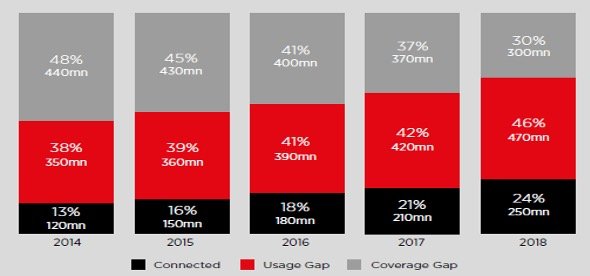Numbers – large potential with same scope of issues. When we speak about Sub Saharan Africa (SSA) everybody is excited by the magic of the numbers:
- 1B people, which comprises 13% of the World’s population, to be doubled by 2050;
- 60% rural population (400M people);
- 215M households.
But on the other hand, SSA:
- provides only 2% of the World’s GDP;
- by 2050 with current population expected to double, 90% of it will be extremely poor, living for less than $2/day;
- electrification rate is only 43%;
- fixed broadband penetration is only 8%;
- mobile broadband is doing a bit better, but still the penetration rate is below 30%.
What are the key challenges to increased connectivity and affordability in Africa?
According to GSMA, mobile internet adoption in SSA is only 24%. Region accounts for 40% of the global population not covered by mobile broadband network. Such small adoption of mobile broadband is affected 46% by the usage gap - lack of affordability and by 30% by the coverage gap – accessibility (Pic.1).
Picture 1. Percentage of SSA population connected to mobile internet over the time Credit: GSMA
Credit: GSMA
Mobile data has become more affordable for African people. The cost of 1GB has reduced to 6.8% of average monthly income in 2018 from 8.6% in 2017 (GSMA). But it still remains above the 2% of monthly income threshold for more than 17 countries of the region.
The two largest barriers for mobile internet adoption in SSA are lack of digital skills or literacy and affordability.
As a result, the majority of mobile connections in SSA are still 2G/3G (voice and SMS), so it remains narrowband. 4G is just start emerging in most countries and mainly in the downtown of big cities. 5G is still somewhere beyond the horizon. So the very important issue that local connectivity providers have been solving is how these users of 2G/3G service can migrate to 4G, or 40% of unconnected population can buy their 1-st 2G/3G mobile phone? The challenge of the first scenario reveals the next layer of problems – lack of digital skills and literacy. So the new adopters shall understand the benefits of consumed data and ready to pay for its value.
Challenge for second scenario is connected with the second barrier for mobile internet adoption in SSA - affordability. But another challenge appears for provider, when the number of 2G/3G users is increasing, as they generate narrowband data. Taking into account all these challenges above, business growth potential for SSA connectivity providers can be achieved either by expanding coverage or by reducing cost of traffic and user terminals.
Technologies for improving digital inclusion
So what technologies are best suited to solve connectivity challenges in the rural areas in Africa?
Based on the experience from other regions, fiber is the best technology for solving connectivity issues. New submarine cables have landed in the past few years in SSA countries, increasing connectivity with the rest of the world. But the terrestrial cabling within SSA remains a bottleneck.
Digging more cables is not an option, as 60% of the population in Africa is located in rural areas. So no one is ready to bring huge investments upfront and dig them into the ground with no money return guaranteed. It is different from other territories, like Russia for example, where a very distant and remote city of 50K+ inhabitants settles far North. Laying fiber there is very difficult, but once you do this, you get all 50K subscribers at once in your network as people live very compact due to harsh conditions and severe environment.
Africa is different. The continent is also large, but very rural. You cannot lay fiber everywhere. MNOs are also struggling to get into rural communities. So satellite is ideal for Africa by assisting in development of various 2/3/4/5G connectivity and reaching as much rural communities as possible via providing backhaul. For amount of $1-2K you can connect a 2/3G BTS on a remote rural site in C/Ku/Ka band, depending on the SLA. If an enhancement to 4G/5G is required, one can simply upgrade the RF ($10K-$15K per site), or migrate to GEO HTS, or invest $100K-$150K and get onto Non-GEO HTS. Sums are quite large, but still much less than laying fiber to every village.
Satellite connectivity market is very competitive now. African service providers can shop for best option, as prices for satellite bandwidth in the region are the cheapest in the world.
Best strategy for service provider
How can existing service providers evolve their business models/strategies to make rural connectivity a reality?
By educating their customers (e.g. regional ISPs and Telcos). Usually the customer in Africa is shopping for the lowest price on the market. And usually this is done at the expense of quality. Such approach has led to a very broad interpretation of the SLA in Africa, where the quality of service may vary from lower actual data rates to serious interruptions. In the end, as a result, the end user is paying more. Large potential in reducing the cost of connectivity for African users (and increasing the affordability) hides in more effective use of the existing hardware and satellite bandwidth.
So it is very important to educate the customer and assist him to find the roots and hidden paths to the cheapest solution without serious degradation in quality.
How to achieve this? For satellite connectivity below is a summary of recommendations successfully implemented by many providers in the region.
Technical:
- working in alternative, not widely used frequencies;
- professional mitigation of terrestrial interference with by installing filters and identifying the source;
- initiate other actions aimed at raising the quality of service may include some not evident actions like installing the lightning rod for the antenna.
Marketing and financial:
- sharing capex and revenues;
- providing modems FOC;
- grace periods;
- higher data rates in a demo mode or as an incentive.
These are the examples of the cooperation with the customers in Africa that satellite operators and service providers are practicing by sharing the risks.
Role of government and regulators
In the context of promoting satellite based rural connectivity what is the role of governments and/or regulatory authorities?
For local regulators it is essential not to block the use of spectrum and not to bring barriers for entry of service providers into their countries. As competition, especially fierce competition, drives the connectivity prices down. So the overall broadband penetration in the country is raising, so that regulators can repot on ICT improvements. If you look at the “closed sky” countries the cost of satellite broadband is well above the average world market price, decreasing the broadband affordability for the citizens.
Also it is important to stipulate satellite connectivity in digital inclusion strategies for the national institutions and communities. Almost every country has got a “National broadband plan”, so satellite connectivity shall be a vital part of it, as only satellite can deliver connectivity fast, instantly and at a scale throughout entire country.
Pandemic – a menace or an opportunity?
Africa, with its long underfunded healthcare systems, may be heavily affected by a pandemic situation quickly spreading all over the globe. However, the fact that Africa is 60% rural may help to stop virus expansion. In these circumstances the role of telemedicine, as well as distant access of the people to basic government, financial and other services is increasing. As we see from current situation examples e-commerce, digital healthcare, education and entertainment are expanding. Satellite is a very reliable and scalable solution to keep these people away from the epidemic but do not exclude them from the business, social and cultural national or regional ecosystems.
In general telecom market will face sales challenges due to retail store closures and supply chain disruption, and may also take an ARPU hit as states insist on bill waive programs to keep the financially weak sectors of society online. Customer support lines will also be affected, as call center staff are required to work from home wherever possible.
But there has never been a more pressing need for digitization. In the long-term, the outlook for telecom sector remains positive, as reliable connectivity becomes a critical commodity. Coming out of COVID-19, millions of users worldwide including Africa will be more connected and more familiar with digital tools. So this is a good chance for Africa to force digital inclusion and raise Internet adoption on the continent. Internet connectivity is no longer a luxury, but an inevitable requirement for post pandemic life of all African people.
RSCC services in Sub Saharan Africa
Russian Satellite Communications Company, as the second oldest satellite operator in the world, has seen many ups and downs of economic, social and political conditions during its 53 years history. And always satellite operator has supported its customers and continuity of services.
A diverse satellite fleet of C and Ku band satellites with five wide and spot beams dedicated to Africa, as well as a wide network of partner satellite connectivity service providers across SSA, can provide African ISPs and Telcos with a unique cost effective scalable solution for satellite IP backbone and cellular backhaul connectivity. The reliability of fiber and microwave backbone links, which have entered many urban conglomerates in Africa, including the land locked countries, is questionable in current pandemic circumstances. As based on the experience such cables and radio links require constant maintenance and cuts repair. And this is quite difficult in the pandemic situation, where most African countries have closed their borders. While satellite links are borderless and can provide a reliable backbone connectivity. So that African ISPs and connectivity providers can sustain quality internet access for their users inside local networks with peak traffic demands caused by increased online services and communications.
***
 Operations Committee
Operations Committee
